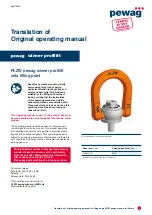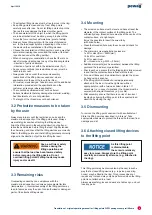
April 2019
6
Translation of original operating manual for lifting points PLZW pewag winner profilift zeta
4. Inspection, maintenance,
repair
The safety of the user
is contingent upon
the effectiveness and
durability of the equipment used. For this reason,
ensure that inspections are performed regularly.
Damaged lifting points may fail during normal
conditions of use, causing the load to fall.
Such lifting points may not be used.
• This product must be inspected by a competent
person at least once a year and in accordance with the
manufacturer‘s instructions. Depending on the conditions
of use and legal stipulations, this interval may be shorter.
In case of frequent use, we recommend a crack test every
two years.
• During tests, all parts must be checked for damage that
could impact safety and function.
• For the regular inspection and the crack test, all parts must
be free from oil, dirt and rust.
Appropriate cleaning processes include those that do not
cause overheating, cover up surface defects or cause
hydrogen embrittlement or stress crack corrosion.
• Load testing all the way up to the proof force is not
permitted for these lifting points.
• Competent persons
are persons who are capable of
assessing the operationality and correct usage of this
product, either based on their technical qualifications
(e.g. training) or their experience with and sufficient
knowledge of the use of lifting equipment, and who are
familiar with the relevant standards and regulations.
If you are interested in an expert training module, please
contact our technical service.
4.1 Inspection
Before each use, the following checks should be
performed:
The lifting points were selected correctly, based on the size
of the load and the lifting devices used (chain sling, angle of
inclination, etc.).
• The lifting point is functioning correctly (ring is rotatable
and/or foldable) and none of the parts look damaged,
(this is particular relevant for the threads).
• The contact surface must fully rest on the load after the
lifting point has been screwed in.
• The ring of the lifting point used must be aligned with the
expected load direction.
Regular inspection:
Regular inspections must be performed by the manufacturer
or a competent person, in strict accordance with the
manufacturer‘s instructions.
4.2 Discard criteria
• Breakage, deformations, sharp notches or cracks of
any kind.
• Signs of excessive heat exposure (e.g. black
discolouration, burn marks in the coating).
• Visible damage to the thread that could impair the
correct functioning of the product.
• Any doubt on the correct functioning/safety of the
lifting point.
• Illegible markings.
• Wear or excessive corrosion,
if the admissible cross-sectional reduction of 10 %
is exceeded.
• If it is not possible to freely rotate and/or fold the ring
after assembly.
If there is any doubt on
the correct functioning/
safety of the lifting point,
it must be discarded!
4.3 Procedure in case of accidents
or faults
If the lifting device gets jammed in the ring of the lifting point,
do not use force to release it as this may cause damage.
If the lifting point shows signs of deformation (e.g. due to
overloading or other unusual events), the product must be
removed from service and handed to a competent person for
inspection or repair.
4.4 Maintenance
• If necessary, clean all the parts using a damp cloth. Leave
the lifting point to air-dry.
• The thread may be cleaned using a wire brush.
4.5 Repairs
• Records must be kept of all inspections and repairs
for the entire lifespan of the product. A sample
documentation sheet is available for download at www.
pewag.com.
• Repairs may only be performed by the manufacturer or a
competent person.
• Refer to the latest catalogue for spare parts such as
screws. Alternatively, contact our technical service.
• Small cuts, notches and grooves may be removed by
careful grinding or filing. After the repair, the treated area
must merge smoothly with the surrounding area, without
the cross-section changing abruptly. By fully removing the
defect, the dimension of the area must not be reduced by
more than 5 %.
• Welding and heat treatment is not permitted.


























